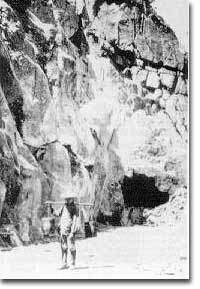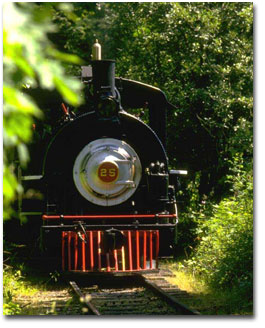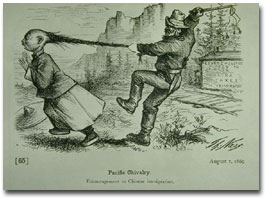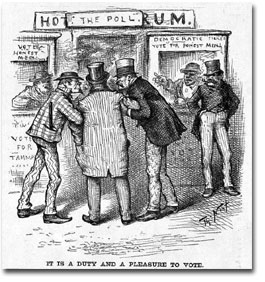| Documentary Segments
Technology
Segment
Technology, and an abundance of natural
resources, were the driving forces behind the Industrial Revolution
in the United States. The telegraph, railroads, the telephone, and
ultimately the use of electricity led to the shift from an agrarian
to an industrial America.
|
Required
Content:
- Industrial
Revolution
- Use of Natural
Resources:
- Transcontinental
Railroad
- Inventors and their
Inventions:
- Samuel F. B. Morse
- Henry Bessemer
- Alexander Graham Bell
- Thomas Alva Edison
|

|
Big Business Segment
Laissez-faire capitalism ruled the day during the
beginning of the Industrial Revolution in the United States. In this
atmosphere of unbridled money-making, numerous types of business
organizations gave rise to Big Business. Were the leaders of these
companies Captains of Industry or Robber Barons? While some used
ruthless business practices to wipe out their competition and earn
large profits, others gave enormous sums of money to charities and
their communities.
|
Required Content:
- Laissez-Faire
Capitalism:
- Adam Smith's The Wealth
of Nations
- Forms of Business
Organization:
- Monopoly
- Conglomerate
- Pool
- Trust
- Holding Company
- Entrepreneurs (Robber
Barons or Captains of Industry?):
- Andrew Carnegie
- John D. Rockefeller
- J. Pierpont Morgan
- Jay Gould
- Henry Ford
- Conspicuous
Consumption
- Philanthropy
|

|
Urbanization
Segment
Urbanization was a direct result of the
Industrial Revolution in the United States. Burgeoning factories
were centralized in cities which offered a central location for
resources and workers to fuel their production. Immigrants and
displaced rural workers flooded cities in the hopes of finding
employment. Throughout the Gilded Age there were several positive,
as well as negative, effects that can be attributed to
urbanization.
|
Required Content:
- Negative Effects of
Urbanization:
- Housing (tenements, slums,
etc.)
- Health (disease, sanitation,
etc.)
- Working Conditions (child
labor, etc.)
- Political Machines (Tamany
Hall, graft, etc.)
- Positive Effects of
Urbanization:
- New Technologies (elevators,
skyscrapers, street lighting, water and sewage systems,
etc.)
- Cultural Benefits (museums,
theaters, parks, libraries, education, etc.)
- Philosophies:
- Puritan Work Ethic
- Social Darwinism (Horatio
Alger, etc.)
|

|
Immigration Segment
The United
States has always been a nation of immigrants. However, during the
Gilded Age, immigration to America increased tremendously. Not only
were more people coming to the United States than ever before, but
they were also coming from different places, and in doing so they
added to the culture of America. But was America becoming a
"melting-pot," or a "salad-bowl" of differing cultures?
|
Required Content:
- Periods of
Immigration:
- Colonial Immigration (time
period, place of origin, difficulties, etc.)
- "Old" immigration (time
period, place of origin, difficulties, etc.)
- "New" Immigration (time
period, place of origin, difficulties, etc.)
- Reaction Against
Immigration:
- Nativism
- Know-Nothing Party
- Chinese Exclusion Act of
1882 ("Yellow Peril")
- National Origins Acts (1924,
1929)
- Theories of
Immigration:
- "Melting-Pot" Theory
- Assimilation
- "Salad-Bowl" Theory
(Pluralism)
|

|
Reactions Segment
The Gilded Age
was a period of immense change in the United States. All of the
abuses and problems of the time generated many different reactions-
most directed at reform. Slowly, government regulations began to
reign in the abuses of big business. At the same time, social
reformers actively sought to correct the problems evident in
American cities.
|
Required Content:
- Granger
Movement:
- Railroad Practices (pools,
rebates, etc.)
- Railroads=Public
Utility
- Bloc Voting
- Granger State Laws
- Munn v. Illinois
(1877)
- Wabash Case
(1886)
- Interstate Commerce Act
(1887)
- Sherman Antitrust Act
(1890)
- Unionism:
- Collective Bargaining
- Knights of Labor
- American Federation of
Labor
- International Ladies'
Garment Workers Union
- Early Reformers:
- Thomas Nast
- Jane Addams (Hull
House)
|

|
|
